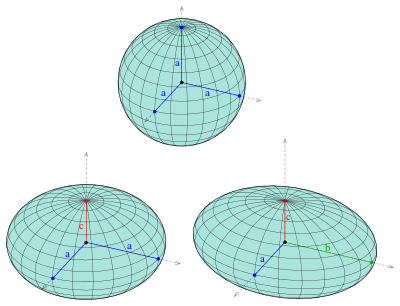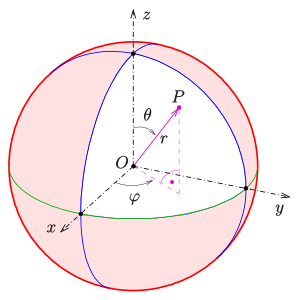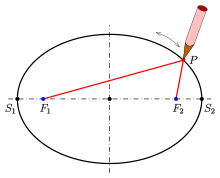Ellipsoid
An ellipsoid is the 3-dimensional equivalent of an ellipse. Just as an ellipse can be conceived as an affine image of the unit circle, applies:
- An ellipsoid (as a surface) is an affine image of the unit sphere
The simplest affine mappings are the scalings of Cartesian coordinates. They provide ellipsoids with equations
Such an ellipsoid is point-symmetric with respect to the point 


- If
, the ellipsoid is a sphere.
- If exactly two semi-axes coincide, the ellipsoid is a rotational ellipsoid.
- If the 3 semi-axes are all different, the ellipsoid is called triaxial or triaxial.
All ellipsoids 
Approximate examples of rotational ellipsoids are the rugby ball and oblate rotating celestial bodies, such as the Earth or other planets (Jupiter), suns, or galaxies. Elliptical galaxies and dwarf planets (e.g. (136108) Haumea) can also be triaxial.
In linear optimization, ellipsoids are used in the ellipsoid method.
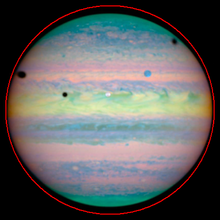
Jupiter's diameter from pole to pole is much smaller than at the equator (red circle for comparison)
Parameter representation
The points on the unit sphere can be parameterized as follows (see Sphere coordinates):
For the angle θ 


Scaling the individual coordinates with the factors 

where 
Volume
The volume of the ellipsoid 
A sphere with radius 
Derivation
The intersection of the ellipsoid 



The area of this ellipse is 
Surface
Surface of an ellipsoid of revolution
→ Main article: Rotational ellipsoid
The surface of an oblate ellipsoid of revolution 
that of the extended ellipsoid (
A sphere with radius 

Surface of a triaxial ellipsoid
The surface area of a triaxial ellipsoid cannot be expressed using functions which are considered elementary, such as 


the integrals are

The surface has with 

If the expressions for 

and
into the equation for 
From Knud Thomsen comes the integral-free approximation formula
The maximum deviation from the exact result is less than 1.2%.
In the limiting case of a completely flattened ellipsoid 




Application example to the formulas
The planet Jupiter is much flatter at the poles than at the equator because of the centrifugal forces acting due to the fast rotation and have approximately the shape of a rotational ellipsoid.
Jupiter has the equatorial diameter 142984 km and the pole diameter 133708 km. So for the semi-axes 

- Volume:
This is about 1321 times the volume of the Earth.
- Mean density:
Jupiter thus has a slightly higher density overall than water under standard conditions.
- Surface:
This is about 121 times the surface area of the Earth.
Plane cuts
Features
The intersection of an ellipsoid with a plane is
- an ellipse if it contains at least two points,
- a point if the plane is a tangent plane,
- otherwise empty.
The first case follows from the fact that a plane intersects a sphere in a circle and a circle turns into an ellipse in an affine mapping. That some of the intersecting ellipses are circles is obvious in the case of a rotational ellipsoid: all plane intersections which contain at least 2 points and whose planes are perpendicular to the axis of rotation are circles. But that also every 3-axis ellipsoid contains many circles is not obvious and is explained in Circle Section Plane.
The true outline of any ellipsoid is a plane section, i.e. an ellipse, for both parallel projection and central projection (see pictures).
Determination of a cutting ellipse
Given: Ellipsoid 

Wanted: Three vectors 

can be described (see ellipse).
Solution: Scaling 




center of the intersection circle is 
If 

If 
The vectors 


If we now undo the above scaling (affine mapping), the unit sphere becomes the given ellipsoid again and we obtain from the vectors 

Example: The images belong to the example with 




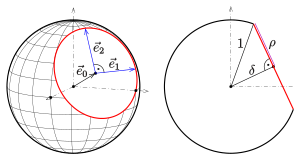
Plane section of the unit sphere

Plane section of an ellipsoid
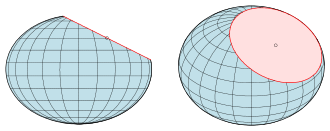
Plane section of an ellipsoid
Thread construction
The thread construction of an ellipsoid is a transfer of the idea of the gardener construction of an ellipse (see figure). A thread construction of a rotational ellipsoid results from the construction of the meridian ellipses with the help of a thread.
Constructing points of a 3-axis ellipsoid using a taut thread is somewhat more complicated. Wolfgang Boehm, in the article Die Fadenkonstruktion der Flächen zweiter Ordnung, attributes the basic idea of the thread construction of an ellipsoid to the Scottish physicist James Clerk Maxwell (1868). Otto Staude then generalized the thread construction to quadrics in papers in 1882, 1886, 1898. The thread construction for ellipsoids and hyperboloids is also described in the book Anschauliche Geometrie by David Hilbert and Stefan Cohn-Vossen. Sebastian Finsterwalder also dealt with this topic in 1886.
Design steps
(1) Choose an ellipse and a hyperbola forming a pair of focal conic sections:
Ellipse: 
Hyperbola:
with the vertices and foci of the ellipse
and a thread (red in the figure) of length 
(2) Fix one end of the thread at the vertex 






(3) If the point 


(4) the remaining points of the ellipsoid are obtained by suitably looping the thread around the focal cone intersections.
The equations for the semi-axes of the generated ellipsoid are obtained by 

From the drawing below you can see that 



From the upper drawing it follows that 

Inversion:
If one wishes to 
a 3-axis ellipsoid 

(5)
Confocal ellipsoids:
If
is an ellipsoid confocal to 
(6)
so one recognizes from the previous equations that the focal cone sections belonging to 


converse is also true: If we choose a second thread of length 


Boundary case rotational ellipsoid:
In the case 

Properties of the focal hyperbola:If
one observes an ellipsoid from an outside point 



In the figure, a parallel projection of a 3-axis ellipsoid (semi-axes: 60,40,30) in the direction of an asymptote is shown in the lower left, and a central projection with center 




The focal hyperbola of an ellipsoid intersects the ellipsoid at its four umbilical points.
Property of the focal ellipse:
The focal ellipse with its interior can be considered as
the interface of
the set of confocal ellipsoids determined
by


Below: Parallel projection and central projection of a 3-axis ellipsoid where the apparent outline is a circle.
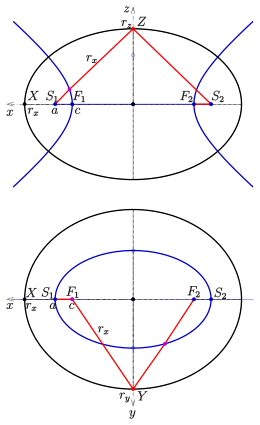
Thread construction: Determination of the semi-axes
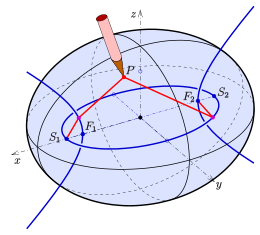
Thread construction of an ellipsoid
Ellipsoid in any position
Parameter representation
An affine mapping can be 


where 
The parameter representation of any ellipsoid results from the above parameter representation of the unit sphere and the description of an affine mapping:
Conversely, if one chooses a vector 




A normal vector at the point 
For a parameter representation of any ellipsoid an implicit description also be 

an implicit representation.
Remark: The ellipsoid described by the above parameter representation is in the possibly skewed coordinate system 

Ellipsoid as quadric
→ Main article: Quadric
Any ellipsoid with center 
where 
The eigenvectors of the matrix 




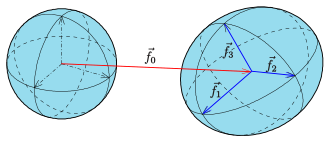
Ellipsoid as affine image of the unit sphere
Ellipsoid in projective geometry
If one closes the 3-dimensional affine space and the individual quadrics projectively by a far plane or far points, the following quadrics are projectively equivalent, i.e., there is in each case a projective collineation which transforms one quadric into the other:
- Ellipsoid, elliptical paraboloid, and 2-shell hyperboloid.
See also
- Ellipsoid of revolution
- Reference ellipsoid
- Inertial ellipsoid
- Index ellipsoid
- Homeoid
- Focaloid
- Confocal quadrics
Search within the encyclopedia


